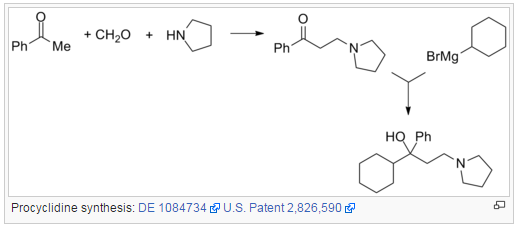Procyclidine
 | |
| Clinical data | |
|---|---|
| AHFS/Drugs.com | Monograph |
| MedlinePlus | a605037 |
| Routes of administration | oral, im, iv |
| ATC code | |
| Pharmacokinetic data | |
| Protein binding | ~100%-albumin |
| Elimination half-life | ~12 h |
| Identifiers | |
| |
| CAS Number |
|
| PubChem CID | |
| DrugBank | |
| ChemSpider | |
| UNII | |
| ChEMBL | |
| E number | {{#property:P628}} |
| ECHA InfoCard | {{#property:P2566}}Lua error in Module:EditAtWikidata at line 36: attempt to index field 'wikibase' (a nil value). |
| Chemical and physical data | |
| Formula | C19H30ClNO |
| Molar mass | 323.9 g/mol |
| (verify) | |
Procyclidine is an anticholinergic drug principally used for the treatment of drug-induced parkinsonism, akathisia and acute dystonia; Parkinson disease; and idiopathic or secondary dystonia.
Uses
It is used in patients with parkinsonism and akathisia, and to reduce the side effects of antipsychotic treatment given for schizophrenia. Procyclidine is also a second-line drug for the treatment of Parkinson's disease. It improves tremor but not rigidity or bradykinesia.
Procyclidine is also sometimes used for the treatment of dystonia (but not tardive dyskinesia), a rare disorder that causes abnormal muscle contraction, resulting in twisting postures of limbs, trunk, or face.
Overdose
Signs of procyclidine overdose are those of an anticholinergic and include confusion, agitation and sleeplessness that can last up to or more than 24 hours. Pupils become dilated and unreactive to light. Tachycardia (fast heart beat), as well as auditory and visual hallucinations have also been reported.
Other known symptoms of overdose are: clumsiness or unsteadiness, being severely drowsy, having a severely dry mouth, nose, or throat, having an altered mood or other mental changes, seizures, being short of breath or having troubled breathing, a dry and warm, flushed skin.
A suspected overdose with severe life-threatening symptoms should immediately be brought to medical attention, where reversal can be attempted with physostigmine administered intravenously or subcutaneously.
Synthesis

Procyclidine, 1-cyclohexyl-1-phenyl-3-pyrrolidinopropan-1-ol, is synthesized in exactly the same manner as was seen for trihexyphenidyl, except this time the linear synthesis begins with the preparation of 3-(1-pyrrolidino)propiophenone.
![Procyclidine synthesis 2[1]](/images/e/ee/Procyclidine_synthesis_2.png)
In an interesting variation, the ketone is first reacted with phenylmagnesium bromide. Catalytic hydrogenation of the carbinol thus obtained can be stopped after the reduction of only one aromatic ring.
See also
References
- ↑ Adamson, D. W.; Barrett, P. A.; Wilkinson, S. (1951). "11. Aminoalkyl tertiary carbinols and derived products. Part IV. Spasmolytics. Phenyl- and cyclohexylphenyl-carbinols". Journal of the Chemical Society (Resumed): 52. doi:10.1039/jr9510000052.
Further reading
- British National Formulary (45 ed.). March 2003.
- Pages with script errors
- Template:drugs.com link with non-standard subpage
- E number from Wikidata
- ECHA InfoCard ID from Wikidata
- Chemical articles with unknown parameter in Infobox drug
- Articles without KEGG source
- Articles without InChI source
- Drugs with no legal status
- Alcohols
- Chlorides
- Muscarinic antagonists
- Pyrrolidines
- Tardive dyskinesia